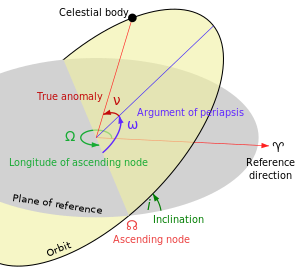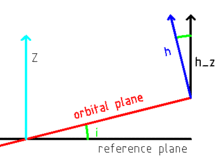Orbital inclination

| Part of a series on |
| Astrodynamics |
|---|
Orbital inclinationmeasures the tilt of an object'sorbitaround a celestial body. It is expressed as theanglebetween areference planeand theorbital planeoraxisof direction of the orbiting object.
For a satellite orbiting the Earth directly above theEquator,the plane of the satellite's orbit is the same as the Earth's equatorial plane, and the satellite's orbital inclination is 0°. The general case for a circular orbit is that it is tilted, spending half an orbit over the northern hemisphere and half over the southern. If the orbit swung between 20° northlatitudeand 20° south latitude, then its orbital inclination would be 20°.
Orbits[edit]
The inclination is one of the sixorbital elementsdescribing the shape and orientation of a celestialorbit.It is theanglebetween the orbital plane and theplane of reference,normally stated indegrees.For a satellite orbiting aplanet,the plane of reference is usually the plane containing the planet'sequator.For planets in the Solar System, the plane of reference is usually theecliptic,the plane in which the Earth orbits the Sun.[1][2]This reference plane is most practical for Earth-based observers. Therefore, Earth's inclination is, by definition, zero.
Inclination can instead be measured with respect to another plane, such as theSun's equator or theinvariable plane(the plane that represents the angular momentum of the Solar System, approximately the orbital plane ofJupiter).
Natural and artificial satellites[edit]
The inclination of orbits ofnaturalorartificial satellitesis measured relative to the equatorial plane of the body they orbit, if they orbit sufficiently closely. The equatorial plane is the plane perpendicular to the axis of rotation of the central body.
An inclination of 30° could also be described using an angle of 150°. The convention is that the normal orbit isprograde,an orbit in the same direction as the planet rotates. Inclinations greater than 90° describeretrograde orbits(backward). Thus:
- An inclination of 0° means the orbiting body has a prograde orbit in the planet's equatorial plane.
- An inclination greater than 0° and less than 90° also describes a prograde orbit.
- An inclination of 63.4° is often called acritical inclination,when describing artificial satellites orbiting the Earth, because they havezero apogee drift.[3]
- An inclination of exactly 90° is apolar orbit,in which the spacecraft passes over the poles of the planet.
- An inclination greater than 90° and less than 180° is a retrograde orbit.
- An inclination of exactly 180° is a retrograde equatorial orbit.
For impact-generated moons ofterrestrial planetsnot too far from their star, with a large planet–moon distance, the orbital planes of moons tend to be aligned with the planet's orbit around the star due to tides from the star, but if the planet–moon distance is small, it may be inclined. Forgas giants,the orbits of moons tend to be aligned with the giant planet's equator, because these formed in circumplanetary disks.[4]Strictly speaking, this applies only to regular satellites. Captured bodies on distant orbits vary widely in their inclinations, while captured bodies in relatively close orbits tend to have low inclinations owing to tidal effects and perturbations by large regular satellites.
Exoplanets and multiple star systems[edit]
The inclination ofexoplanetsor members ofmulti-star star systemsis the angle of the plane of the orbit relative to the plane perpendicular to the line of sight from Earth to the object.[5]
- An inclination of 0° is a face-on orbit, meaning the plane of the exoplanet's orbit is perpendicular to the line of sight with Earth.
- An inclination of 90° is an edge-on orbit, meaning the plane of the exoplanet's orbit is parallel to the line of sight with Earth.
Since the word "inclination" is used in exoplanet studies for this line-of-sight inclination, the angle between the planet's orbit and its star's rotational axis is expressed using the term the "spin-orbit angle" or "spin-orbit alignment".[5]In most cases the orientation of the star's rotational axis is unknown.
Because theradial-velocity methodmore easily finds planets with orbits closer to edge-on, most exoplanets found by this method have inclinations between 45° and 135°, although in most cases the inclination is not known. Consequently, most exoplanets found by radial velocity havetrue massesno more than 40% greater than theirminimum masses.[citation needed]If the orbit is almost face-on, especially for superjovians detected by radial velocity, then those objects may actually bebrown dwarfsor evenred dwarfs.One particular example isHD 33636B, which has true mass 142 MJ,corresponding to an M6V star, while its minimum mass was 9.28 MJ.
If the orbit is almost edge-on, then the planet can be seentransitingits star.
Calculation[edit]

Inastrodynamics,the inclinationcan be computed from theorbital momentum vector(or any vector perpendicular to theorbital plane) as whereis the z-component of.
Mutual inclination of two orbits may be calculated from their inclinations to another plane usingcosine rule for angles.
Observations and theories[edit]
Most planetary orbits in the Solar System have relatively small inclinations, both in relation to each other and to the Sun's equator:
| Body | Inclination to | ||||||||||
|---|---|---|---|---|---|---|---|---|---|---|---|
| Ecliptic | Sun's equator |
Invariable plane[6] | |||||||||
| Terre- strials |
Mercury | 7.01° | 3.38° | 6.34° | |||||||
| Venus | 3.39° | 3.86° | 2.19° | ||||||||
| Earth | 0°
|
7.25°[7] | 1.57° | ||||||||
| Mars | 1.85° | 5.65° | 1.67° | ||||||||
| Gas & ice giants |
Jupiter | 1.31° | 6.09° | 0.32° | |||||||
| Saturn | 2.49° | 5.51° | 0.93° | ||||||||
| Uranus | 0.77° | 6.48° | 1.02° | ||||||||
| Neptune | 1.77° | 6.43° | 0.72° | ||||||||
| Minor planets |
Pluto | 17.14° | 11.88° | 15.55° | |||||||
| Ceres | 10.59° | 9.20° | |||||||||
| Pallas | 34.83° | 34.21° | |||||||||
| Vesta | 5.58° | 7.13° | |||||||||
On the other hand, thedwarf planetsPlutoandErishave inclinations to the ecliptic of 17° and 44° respectively, and the largeasteroidPallasis inclined at 34°.
In 1966,Peter Goldreichpublished a classic paper on the evolution ofthe Moon's orbitand on the orbits of other moons in the Solar System.[8]He showed that, for each planet, there is a distance such that moons closer to the planet than that distance maintain an almost constant orbital inclination with respect to the planet's equator (with anorbital precessionmostly due to the tidal influence of the planet), whereas moons farther away maintain an almost constant orbital inclination with respect to theecliptic(with precession due mostly to the tidal influence of the sun). The moons in the first category, with the exception ofNeptune's moonTriton,orbit near the equatorial plane. He concluded that these moons formed from equatorialaccretion disks.But he found that the Moon, although it was once inside the critical distance from the Earth, never had an equatorial orbit as would be expected from variousscenarios for its origin.This is called the lunar inclination problem, to which various solutions have since been proposed.[9]
Other meaning[edit]
For planets and other rotating celestial bodies, the angle of the equatorial plane relative to the orbital plane – such as the tilt of the Earth's poles toward or away from the Sun – is sometimes also called inclination, but less ambiguous terms areaxial tiltor obliquity.
See also[edit]
- Horizontal coordinate system
- Axial parallelism
- Axial tilt
- Azimuth
- Beta angle
- Kepler orbits
- Kozai mechanism
- Orbital inclination change
- Orbital pole
- Space Shuttle Columbia disaster: Possible emergency procedures
References[edit]
- ^Chobotov, Vladimir A. (2002).Orbital Mechanics(3rd ed.).AIAA.pp. 28–30.ISBN1-56347-537-5.
- ^McBride, Neil; Bland, Philip A.; Gilmour, Iain (2004).An Introduction to the Solar System.Cambridge University Press.p. 248.ISBN0-521-54620-6.
- ^Arctic Communications System Utilizing Satellites in Highly Elliptical Orbits,Lars Løge – Section 3.1, Page 17
- ^Moon formation and orbital evolution in extrasolar planetary systems-A literature review,K Lewis – EPJ Web of Conferences, 2011 – epj-conferences.org
- ^abTiago L. Campante (27 October 2016)."Spin-orbit alignment of exoplanet systems: Analysis of an ensemble of asteroseismic observations"(PDF).Proceedings of the International Astronomical Union.11(General Assembly A29B). Cambridge University Press: 636–641.Bibcode:2016IAUFM..29B.636C.doi:10.1017/S1743921316006232.S2CID126328423.Retrieved27 February2022.
- ^Heider, K.P. (3 April 2009)."The mean plane (invariable plane) of the Solar System passing through the barycenter".Archived fromthe originalon 3 June 2013.Retrieved10 April2009.
- produced using
- produced using
- ^Planetary Fact Sheets,athttp://nssdc.gsfc.nasa.gov
- ^Peter Goldreich (November 1966). "History of the Lunar Orbit".Reviews of Geophysics.4(4): 411–439.Bibcode:1966RvGSP...4..411G.doi:10.1029/RG004i004p00411.Termed "classic" byJihad Touma&Jack Wisdom(November 1994)."Evolution of the Earth-Moon system".The Astronomical Journal.108:1943.Bibcode:1994AJ....108.1943T.doi:10.1086/117209.
- ^Kaveh Pahlevan & Alessandro Morbidelli (26 November 2015). "Collisionless encounters and the origin of the lunar inclination".Nature.527(7579): 492–494.arXiv:1603.06515.Bibcode:2015Natur.527..492P.doi:10.1038/nature16137.PMID26607544.S2CID4456736.




